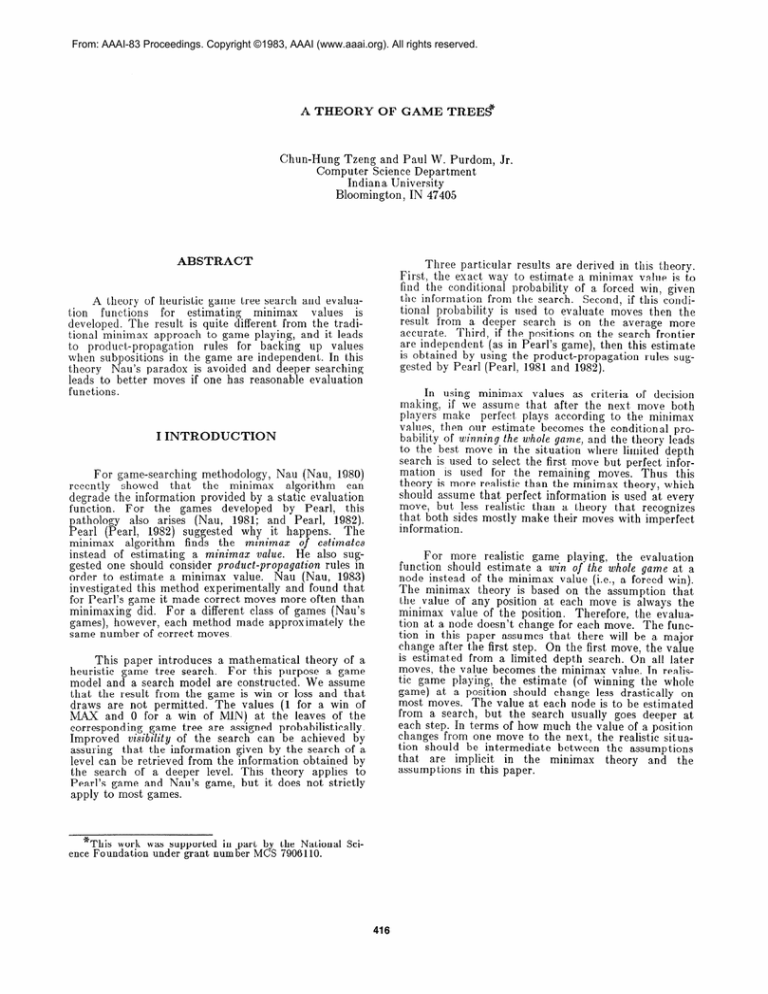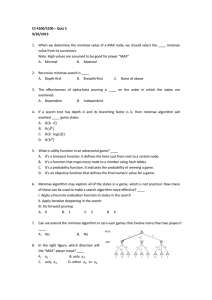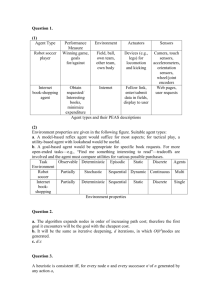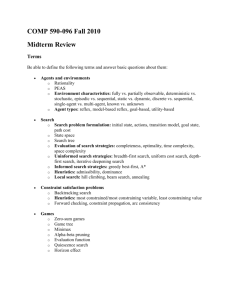
From: AAAI-83 Proceedings. Copyright ©1983, AAAI (www.aaai.org). All rights reserved.
A THEORY
OF GAME
TREE$
Chun-Hung
Tzeng and Paul W. Purdom,
Computer Science Department
Indiana University
Bloomington,
IN 47405
ABSTRACT
A theory of heuristic game tree search and evaluation
functions
for estimating
minimax
values
is
developed.
The result is quite different from the traditional minimsx
approach
to game playing, and it leads
rules for backing
up values
to product-propagation
when subpositions
in the game are independent.
In this
theory
Nau’s paradox is avoided and deeper searching
leads to better moves if one has reasonable
evaluation
functions.
I INTRODUCTION
For game-searching
methodology,
Nau (Nau, 1980)
recently
showed
that
the minimax
algorithm
can
degrade the information
provided by a static evaluation
For the games
developed
by Pearl,
this
function.
pathology
also arises (Nau, 1981; and Pearl,
1982).
Pearl (Pearl,
1982) suggested
why it happens.
The
minimax
algorithm
finds the minimaz
of e&n&es
instead
of estimating
a minimas
value. He also suggested one should consider product-propagation
rules in
order to estimate
a minimax
value.
Nau fNau. 1983)
investiga.ted
this method experimentally
and fo&d that
for Pearl’s game it made correct moves more often than
minimaxing
did. For a different class of games (Nau’s
games), however, each method made approximately
the
same number of correct moves.
This paper introduces
a mathematical
theory of a
heuristic
game tree search.
For this purpose a game
model and a search model are constructed.
We assume
that the result from the game is win or loss and that
draws are not permitted.
The values (1 for a win of
MAX and 0 for a win of MN) at the leaves of the
corresponding
game tree are assigned probabilistically.
Improved
visibility of the search can be achieved
by
assuring
that the information
given by the search of a
level can be retrieved from the information
obtained
by
the search of a deeper level. This theory
applies to
Pearl’s game and Nau’s game, but it does not strictly
apply to most games.
*This work was supported in part b the National
ence Foundation under grant number M cyS 7900110.
Sci-
Jr.
Three particular
results are derived in this theory.
First, the exact way to estimate
a minimax value is to
find the conditional
probability
of a forced win, given
the information
from t,he search.
Second, if this conditional probability
is used to evaluate
moves then the
result from a deeper search is on the average more
accurate.
Third, if the positions on the search frontier
are independent
(as in Pearl’s game), then this estimate
is obtained by using the product-propagation
rules suggested by Pearl (Pearl, 1981 and 1982).
In using minimax
values as criteria
of decision
making, if we assume that after the next move both
players make
perfect plays according
to the minimax
values, then our estimate
becomes the conditional
probability of winning the whole game, and the theory leads
to the best move in the situation
where limited depth
search is used to select the first move but perfect information
is used for the remaining
moves. Thus this
theory is more realistic than the minimax theory, which
should assume that perfect information
is used at every
move, but less realistic than a theory that recognizes
that both sides mostly make their moves with imperfect
information.
For more realistic
game playing,
the evaluation
function should estimate
a win of the whole game at a
node instead of the minimax value (i.e., a forced win).
The minimax
theory is based on the assumption
that
the value of any position at each move is always the
minimax value of the position.
Therefore,
the evaluation at a node doesn’t change for each move. The function in this paper assumes that there will be a major
change after the first step. On the first move, the value
is estimated
from a limited depth search. On all later
moves, the value becomes the minimax value. In realistic game playing, the estimate
(of winning the whole
game) at a position
should change less drastically
on
most moves. The value at each node is to be estimated
from a search, but the search usually goes deeper at
each step. In terms of how much the value of a position
changes from one move to the next, the realistic situation should be intermediate
between
the assumptions
that
are implicit
in the minimax
theory
and the
assumptions
in this paper.
II AN EXAMPLE
III PROBABILISTIC
For purposes
of theoretical
study,
Pearl
Pearl,
1980) considered
a special kind of games.
A L earl’s
game is represented
by a complete
uniform game tree
with a branching
factor d (2 2 , where the terminal
nodes may assume I. ja win for LAX ) or 0 (a win for
MIN) with a probablhty
of p and 1 - p, respectively.
Nau (Nau, 1983) considered
a different kind of games.
A Nau’s game also has a complete uniform game tree.
To assign LOSS or WIN at terminals,
each arc of the
game tree is independently
given the value 1 or -1 with
a probability
of p and 1 - p, respectively.
Then the
strength
of a terminal is defined as the sum of the arc
values on the path from the terminal to the root. The
terminal
is given WIN if its strength
is positive,
and
LOSS otherwise.
Consider a game tree T with lz leaves and h levels.
Without
loss of generality,
we assume that all game
trees discussed
in this paper have their leaves on the
same
level.
All
leaf-patterns
CJ = (xi, . . . , x~),
xi = 0 or I, form the space 0 = (0, I}“. If the values
on the leaves are assigned according
to a probability
measure
P on 0 w.r.t. the total Bore1 field (Chung,
1974) F (i.e., the collection of all subsets of St), then we
say that these games are in a probabilistic
model:
Definition
these
T with
Definition 2. Let ($2, P) be a probabilistic
game model
for a game tree with h levels and k leaves.
Then a search
5’ on this model
is probabilistic
if S consists
of an
increasing
sequence
of Bore1 fields
where
F, = (4,
1 2 i < h) is
w E
I euj-pattern
the event
E of
UEEEFi,i=l,...,
sets
In a probabilistic
game model (St, P) with a probabilistic search (3.1), we define the estimation
of the
minimax
value IV (a random
variable on fl) at any
fixed node of the game tree as follows.
E;’ .
E....
=
t 1121314
Definition 3.
Xl
x5
+
+
52
x6
=
=
2.1,
i3,
x3
x7
+
+
x4
x8
=
=
fl} is the trivial Bore1 field and each Fi
generated
by a partition
of fl. For each
St, the search
S at level i determines
the partition
generating
Fi such that
h.
The increasing
sequence (3.1) is the improved
visibility of the search. In our example, F, is generated
by
all events Eh, F, by all E;~‘s, and all Ei,i2i3i4’s generate
F,.
For a general Pearl’s game or a Nau’s game (Nau,
1983), the heuristic search that finds the number of l’s
on the leaves under the searched node is similarly probabilistic.
form
a
finer
partition
of
0:
The events given by the search of
level 3 are of the form
EI, = Ui+j=k
I.
A probabilistic
game model for a game
h levels and k leaves is a pair (0, P), where
fl = (0, I}” and P is a probability
measure
on R w.r. t.
the total Bore1 field.
tree
To illustrate
the idea of the new search model, let
us consider an uniform binary game tree of four levels,
where the terminal
nodes may have independently
the
value 1 (win for MAX) or 0 (loss for MAX) with a pro< 1) and
1 - p, respectively.
bability
of p (0 <
thus becomes
The space 0 = (0, 1P8 of all leaf-patterns
Assume that the heuristic
search
a probability
space.
finds the number of winning leaves under the searched
node. We associate each value k (k = 0, . . . ,8) at the
the
with
event
root
R is divided
Ek = {(Xl, * * . ,x8) E n 1 C;8,r X~ = k}.
into 9 different such events, which form a partition
of
the
searched
values
i
and
R.
Similarly,
j (0 5 i, j < 4) at the nodes of level 2 are associated
with the eves
All
MODELS
i,,
For each i, 0 5 i 5 h, the conditional
the
minimux
value
A4 w.r.t.
Fi,
is called the i-th evaluation
function
i4}
Given an event E of level i, the value of pi is
IMi(W) = P(M=l
1 E)
for all w E E, which is just the
conditional
probability
of a forced win, given E.
i,, is, i4 < 2) and form the finest partition
of
relation
The
Eij = (Ji,+ i2=i, i3+ i4=jEi,i2i3i4.
and
(i, + i, = i, i3 + i, = j,
Eili2i3i4 C Eij C Eh
g L i,,
from a deeper
i+
j =k) means that the information
visibility
is
level is more accurate? and the improved
thus formalized
in this simple way. This formulation
also holds for the general Pearl’s games and Nau’s
games.
From the increasing
sequence (3.1), we know that
the sequence
Ch~i, F.}
forms a martingale
(Chung,
1974):
A~i = E(~j
1 Fi)
for 0 -2 i < j < il.
In
words, nli IS an average of A4i if i < j. From this property the following theorem IS derived (Tzeng and Purdom, 1982):
417
V PRODUCT-PROPAGATION
This theorem shows that given the estimations
of
two levels, the deeper one has all the information
and,
therefore,
the other estimation
can be dispensed with.
Consider
the backing up process on our example.
Let A4 be the minimax value at the root, M, and M,
the minimax values at the left son and the right son of
the root, respectively.
Given the searched event Eij of
level 2, the estimation
of M is
P(M
IV DECISION
= 1 I E;j)
P(M
MAKING
=
= 1 1 CiEIXk
= i, C:,5xk
If the root is a MIN node, then
Let MAX move from a node A with n different
children B,, . . . , B,. Let T be the current game tree
with A as the root.
pose that the game is in a proP) with a search (3.1). Let
minimax
value at the node
of level j (1 < j 2 h ), conside
the est’mation
of M(‘) for each i-(1 < i < n):
Mlif = E(Mb)
1 F).
If a move is said to becorrect
if
and only if a node &ith minimax value 1 is chosen, then
we have the following main result:
Theorem
2.
A decision
making
method
that depends
on the search.
of a fixed level j, .which chooses
the node
with the largest
estimation
M/‘) (1 5 i 5 n), will be
improved,
if j is increased.
Proof.
(1 2 j,
game in
level j,
more,
Given the information
of
< j, 5 h), suppose that for
this model the node Bx-, is
and Bk, is chosen relative to
for this fixed game let ~j, (%)
Mb+,) = y1, M.@“) = y2* Then
Fi!dm
T%eorem
levels jr and j,
an arbitrary
fixed
chosen relative to
level j,. Further= x1, My‘) = x
21
x1 2 y1 and’L2 < y2.
1
we
have
level j, is a forced win is always greater than or equal
to the conditional
probability
that the chosen node relative to level j, is a forced win. Since it is a sum of all
such conditional
probabilities,
the probability
that the
chosen node relative to the level i, is a forced win is
therefore
greater than or equal to*t%e probability
that
the chosen node relative to the level j, is a forced win.
If x2 < y2 for at least one game in this model, then the
decision making of the deeper level is strictly improved.
QED.
Note
that
the
estimation
Afji) (1 < j < h)
depends on the search of the whole tree T &stead of
the subtree
Ti under the node Bi.
But if the searched
moves are independent
as in Pearl’s games, then each
estimation
depends on the corresponding
subtree only
(Tzeng and Purdom, 1982).
RULES
P(M = 1 I C&xk
PWI
it can be proved
= i, Ctz5xk = j) =
= 1 1 c/f=19
= i)P(M,
If the root is a MAX
equation becomes
P(M = 1 1 Ck4&
(1 - P(M,
= j).
node,
= i))(l
(5.1)
= 1 I J5iz5xk = j).
then
= i, CfE5xk
= 1 1 C&Zk
that
- P(M,
the
corresponding
= j) = 1 = 1 1 C&Q
(5.2)
= j)).
P(M, = 1 1 c;&
= i)
and
= j) are the estimates
at the two chilThe rules (5.1) and (5.2), called the
product-propagation
rules, hold because of the independence of the values at the leaves.
This process also
applies to general Pearl’s games for the search of each
level. For more general independent
cases, this result
can be formalized
and proved
(Tzeng and Purdom,
1982).
The
Ppf,
dren
values
= 1 C&k
of t Ile root.
In Nau’s games, nodes on the same level are generally dependent
and thus these rules are not applicable. For the general dependent
case, the evaluation
function
exists
so far only theoretically.
Practical
methods
of finding its values should depend
on the
dependence
of the searched nodes and should be studied
for each individual
case.
The
product-propagation
method
is only for the independent
case, and if it is
applied to general games, some unexpected
features like
Nau’s pathology
are also possible.
CONCLUSIONS
The research
reported
here illustrates
the importance of search
uncertainty
and search visibility
in
developing
a realistic mathematical
model of heuristic
search in game trees. In the presence
of uncertainty,
minimaxing
is not the optimum method to combine the
values obtained from the search.
REFERENCES
[I]
(21
Chung,
K. L., A Course
New York, Academic Press
in
Probability
Theory.
1974.
Knuth,
D. E. and R. N. Moore,
Alpha-Beta
Pruning,”
Artificzal
(1975) 293-326.
“An Analysis
of
Intelligence
6
[3]
Nau, D. S., “Decision
Quality
as a Function
of
Search Depth of Game Tree.” Technical
Report
TR-866, Computer
Science Department,
University
of Maryland,
1980.
[4]
Nau, D. S., “Pearl’s Game is Pathological.”
Technical Report
TR-999,
Computer
Science Department, University
of Maryland,
January 1981.
[5]
Nau, D. S., “Pathology
on Game Trees Revisited,
and an Alternative
to Minimaxing,”
Artificial
Intelligence 21 (1983) 221-244.
Nilsson,
N.,
Principles
of Artificial
Intelligence.
Palo Alto, CA. Tioga Publishing
Company,
1980.
[7]
Pearl, J., “Asymptotic
Properties
and Game-Searching
Procedures,”
gence 14 (1980) 113-138.
of Minimal
Artificial
trees
Intelli-
[8]
Pearl,
J., “Heuristic
Search
Theory:
Survey
of
Recent
Results.”
UCLA-ENG-CSL-8017,
June
1980, Proc.
7th Int. Joint
Conj.
on AI, August
1981.
PI
Pearl, J., “On the Nature of Pathology
in Game
Searching.”
UCLA-ENG-CSL-8217,
January 1982.
[IO]
Tzeng, C.-H. and Purdom,
P. W., “A Theory of
the
Heuristic
Game
Tree
Search.”
Technical
Report No. 135, Department
of Computer
Science,
Indiana University,
December 1982.
419






